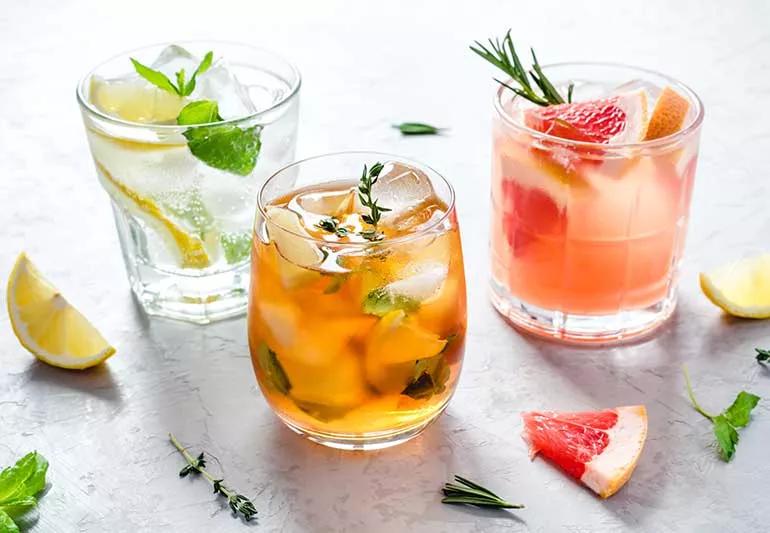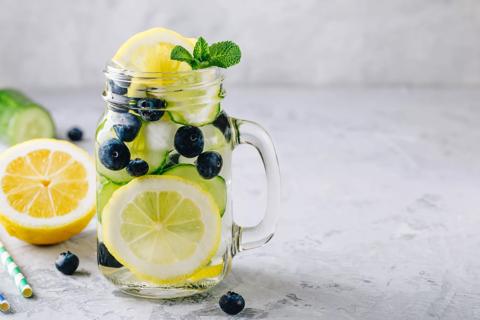If you can’t bear the standard stuff, TikTok’s ‘water recipes’ may be appealing

You already know about the concept of a home bar, whether it’s a shelf, mantle or a fancy wheeled cart where you display your finest spirits and mixers. But TikTokkers have put a new spin on this old trend, removing alcohol from the equation and focusing their mixology skills on H20 instead.
Advertisement
Cleveland Clinic is a non-profit academic medical center. Advertising on our site helps support our mission. We do not endorse non-Cleveland Clinic products or services. Policy
#WaterTok, as it’s called, has become so popular that some retail stores report selling out of flavored syrups, powders and other mix-ins that are commonly used in these “water recipes.”
But just how healthy is it to add a bunch of colorful ingredients to plain old water? And can it really help you stay hydrated?
Actually, the answer might surprise you.
Registered dietitian Beth Czerwony, RD, LD, explains why these water-based creations aren’t all that worrisome, as far as your health is concerned. But she also shares other ideas to help you stay hydrated sans sweet additives.
“WaterTok” is the collective name for the TikTok trend of adding artificially sweetened syrups, powders and other mixes to big tumblers full of ice water. These ingredients often have brand names and flavors that include words like “unicorn,” “mermaid” and “magic,” meant to signify the fun and whimsy of getting creative with an otherwise basic beverage.
“A lot of people don’t like to drink plain water, so they create these concoctions to make them more drinkable,” Czerwony explains.
Importantly, most of these mix-ins aren’t made with real sugar, so they’re both sugar-free and zero-calorie. TikTokkers say this means you can drink them endlessly, staying hydrated without racking up extra calories or impacting your blood sugar.
Advertisement
In fact, the whole idea behind WaterTok originated from bariatric patients. When you’re recovering from weight loss surgery, you aren’t allowed to have carbonated beverages like soda or even fizzy water for at least three months.
“Some of my patients have even gotten fancy water filtration systems and set up little bar areas with droppers and serums to add to their water,” Czerwony shares.
There’s a lot of hype around WaterTok, with some healthcare providers warning that it could be a gateway to unhealthy, sugar-laden habits. But Czerwony says water recipes don’t necessarily deserve the negative reputation they’ve garnered.
“From a health perspective, one of our biggest concerns is making sure that people stay hydrated,” she says. “Plain water is best, but as long as you’re not making sugar-based drinks, and as long as you’re not sensitive to the sweeteners that you’re using, then I don’t see a big problem with these additions.”
That might seem confusing, given all the bad press these days around artificial sweeteners. Once touted as healthy alternatives to sugar, more and more info tells us that they’re not the perfect swap we once thought — but not all sweeteners are the same.
Here’s a quick rundown of what to look for and what to stay away from, whether you’re buying WaterTok mix-ins or anything else:
First things first: If you’re dead set on mixing something sweet into your water, stay away from real sugar. It’s associated with all kinds of health problems, including Type 2 diabetes and heart disease — and that’s just the beginning.
Artificial sweeteners are human-made compounds that taste like sugar but have very few calories. Some common types are saccharin (Sweet n’ Low®) and aspartame (Equal®).
The U.S. Food and Drug Administration (FDA) says artificial sweeteners are safe for human consumption, but like anything else, it’s best to consume them in moderation. Plus, some people are sensitive to them, so keep an eye on how they make you feel.
Instead of artificial sweeteners, look for powders or syrups made with plant-based sweeteners, which are less likely to cause sensitivities. They include:
Sugar alcohols are a type of sweetener that aren’t as sweet as real sugar but has a chemical structure similar to it.
Often found in products labeled “diabetes-friendly” or “keto-friendly,” common types include xylitol and erythritol — any ingredient ending in “tol.” They can have side effects like gas, bloating and diarrhea. And some have been associated with the risk of cardiovascular issues, like heart attacks and strokes.
Advertisement
But here’s the thing: Sugar alcohols aren’t an ingredient in flavor enhancers.
“Sugar alcohols aren’t in the kind of products you’d use for water recipes,” Czerwony clarifies. “You’re going to find them in packaged items like protein bars and sugar-free cookies, not in flavor enhancers.”
For a few glasses of water a day, Czerwony says there’s mostly no harm in water recipes. But she responds to some of the biggest criticisms of the trend:
This is a real risk, Czerwony says, as some people are especially sensitive to sweeteners. “Most of the time, you’ll know pretty quickly if you have a sensitivity to artificial sweeteners. The biggest side effect is really bad headaches.”
But she notes that different people react differently (or not at all) to various types of sweeteners, so if you discover that have side effects from one of them, you can experiment with switching to another.
Some WaterTok skeptics have expressed concern that hopping on the WaterTok bandwagon will lead people to drink too much water. Water intoxication, as it’s known, is an electrolyte imbalance that can cause confusion, nausea and vomiting.
But Czerwony says most aren’t drinking anywhere close to that amount of water. “I just don’t know too many people for whom overhydration is going to be a problem.”
Advertisement
It’s much more common to get too little water, so make sure you know the signs of dehydration and focus on getting the right amount for you.
Even artificial sweeteners and natural sugars can kick your sweet tooth into high gear, causing you to crave more sweet, sugary foods. But as the saying goes, “Everything in moderation.”
“You definitely shouldn’t be drinking equal parts water and syrup,” Czerwony cautions. “We’re talking about a few drops of ‘skinny syrup’ here or a powder packet there.”
In these amounts, the benefits outweigh the risks, especially if you’re someone who didn’t drink enough water until you discovered WaterTok. “If it’s between a sugar-laden soda or an artificially sweetened water drink, then the water is definitely preferable,” she adds.
For people who don’t like the taste of plain water or who are trying to cut back on super-sweet beverages, the WaterTok trend offers an opportunity to stay hydrated without veering into super-unhealthy territory.
And it puts you in the perfect spot to start to scale back on those water mix-ins so you can stay hydrated and beat sugar cravings.
“Your taste buds actually slough off and regenerate every 10 days or so,” Czerwony explains, “so if you want to get more acclimated to plain water, you can certainly wean yourself off of your water-based mixes and start to get used to it.”
Advertisement
Still, it’s ideal to drink something that isn’t loaded up with other stuff, so here’s how you can tap into some other ways to get creative with your hydration:
One more tip: Though water is the most basic of beverages, it’s also important to remember that it doesn’t all hit the same. Try to figure out how you do like to drink it: Ice-cold on the rocks, warmed in a mug with lemon, filtered at room temp? Identify your water preferences — and then drink up.
But if you’re in the starting phases of trying to be better about hydration, Czerwony says, then don’t feel guilty about your newfound interest in WaterTok and the creative water connections it’s inspired you to drink. “Ultimately, if you weren’t getting enough water, and this is a way to get you to drink more of it, then I’m in favor of it.”
Learn more about our editorial process.
Advertisement

Consumption needs vary based on activity, weather, metabolism and other factors

A glass of lemon water in the morning can help with digestion and boost vitamin C levels, and may even help get you into a better routine

Mold and bacteria in your reusable water bottle can cause health issues like infections, respiratory issues and allergic reactions

Sitting in the dry heat may help reduce stress, improve heart health and relieve pain

Adding salt to your water isn’t going to have measurable benefits — but there may be plenty of downsides

Drinking untreated water can have dangerous consequences, like bacterial infections

Although it adds to your hydration, this water may be pushing you over the limit of the daily recommended dosage of caffeine

If you’re trying to drink less soda or fewer sugary drinks, flavored water can be a delicious and healthy alternative

Babies can get congested easily, but you can calm their cough by keeping them hydrated, using nasal drops and running a humidifier

Weight loss may cause loose, sagging skin and muscle loss to your rear

Several conditions, like vitiligo and fungal infection, can cause a loss of pigmentation, leading to white spots or patches on your skin